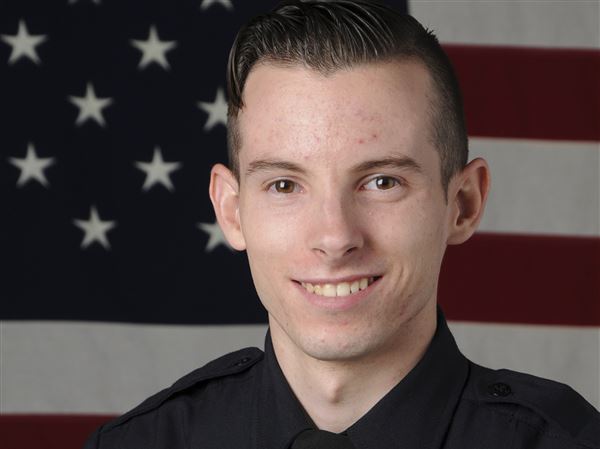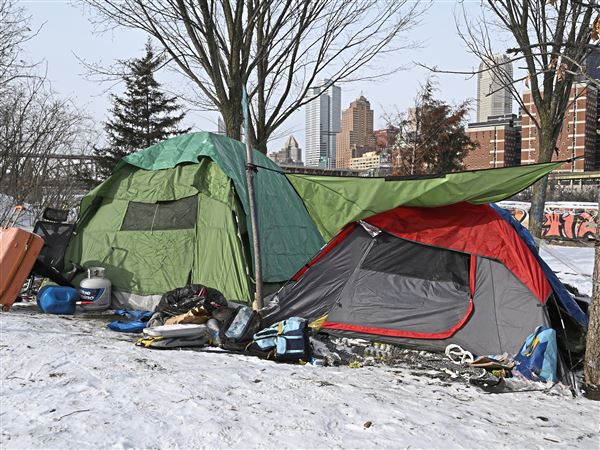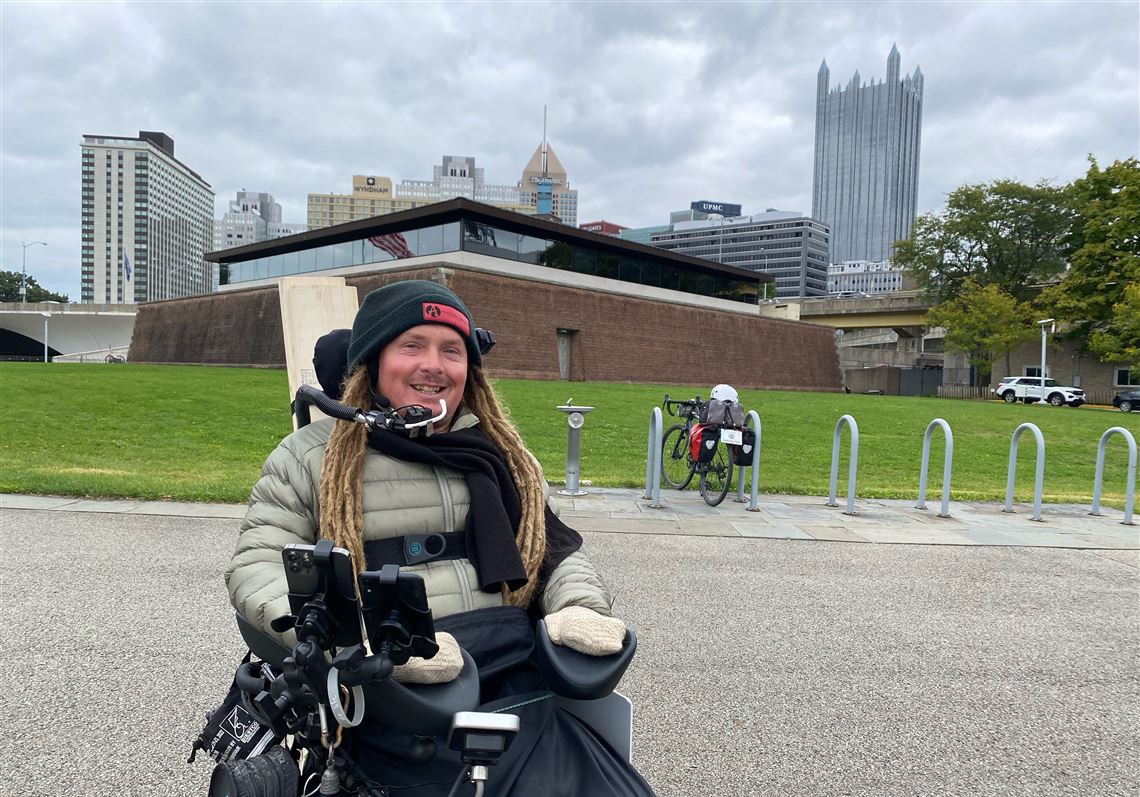Two individual stairs were enough to stop Ian Mackay in his tracks.
Using a motorized wheelchair controlled by blowing into a plastic tube near his mouth, Mackay found himself unable to proceed on the C&O Canal Towpath trail until he came up with a way to move past the steps. He and his travel partners eventually devised a DIY solution by using a concrete slab as a ramp and corralling some fellow hikers to help move him and his 300-pound chair over the steps.
“I think often, it’s easy to overlook,” he said, imagining what a bicyclist on the path might think: “‘A set of stairs, I can easily just step off and walk down them.’
“For me, it was impassable.”
It represented more than just an obstacle for Mackay, who recently spent 12 days traveling the C&O trail and the Great Allegheny Passage from Washington, D.C., to Ohio to highlight the need for accessibility in public lands. It was a flaw in the design of the trail itself, which he chose in part because it was built on an old train line.
Rail trails, he said, are ideal for hiking in a wheelchair because they have gradual grade changes, few narrow passages and usually a smooth path. He had high hopes for the trail because it avoided going along highway shoulders, which Mackay described as a prevalent and dangerous feature of other trails he had hiked.
But still there were obstacles and annoyances, including fallen trees and gravel path surfaces, which can cause physical discomfort and possible hardware damage for someone using a wheelchair.
“It’s going to rattle your teeth all day, it’s going to shake these screws, your chair is going to see some damage,” Mackay said during an interview in Point State Park, where he was resting for lunch on day nine of his trip.
The ride to the Point from where Mackay rested in McKeesport was smooth and accessible for mostly all mobility devices, he said, but he noted that hikers with accessibility needs may want to do some extra preparation and planning since that section of the trail was mostly inaccessible to automobiles.
Mackay lost movement of his limbs after a bicycle accident in 2008. A 26-year-old studying biology at the University of California, Santa Cruz, he was riding home from a school laboratory when he crashed into a tree after hitting some sand while speeding down a trail, breaking his neck.
As he recovered at home, he found himself stuck in a cycle: watching old sitcoms (“I Love Lucy” and “The Andy Griffith Show” were favorites), playing computer games and staying indoors all day. It was miserable, he said.
“You’re 26 years old, you kind of have your plans for your life, your passions, and you also really identify yourself with your physical being,” Mackay said. “You know what you do, what you can do. And with that taken from you, it’s a mindbender trying to figure out what the future holds.”
He started small by going out to the backyard of his home in Washington State every day. Then he began traveling to the Olympic Discovery Trail, less than a mile away. Mackay started to realize that his passions didn’t need to change, but he needed to learn how to approach them in a different way.
His family, West Coast natives who lived in Washington and parts of southern California, was outdoorsy – he grew up going fishing, hiking and riding vehicles off-road. Not long before he was injured, his professor and friend took him along on a 10-day bicycle tour of northern California.
It was an awesome mix of gorgeous views, tasty beer at local breweries and outdoor splendor, Mackay remembered. “I just really enjoyed that, and I was eager to go do it on my own, but then I broke my neck and I felt like that was out of reach. But here we are, doing that in our own way right now.”
Although he advocates for accessible outdoor recreation, he carefully points out that he’s not trying to make every trail abide by the Americans with Disabilities Act, but rather to encourage people to think about how they can keep public, outdoor spaces accessible and usable for everyone.
The ride proceeded at a fast pace. Mackay’s mother, Teena Woodruff, said he was determined to go from Washington, D.C. to Columbus, Ohio, in less than two weeks, with his wheelchair averaging about 8 mph and only a few built-in stops for rest and recreation.
But Mackay, taking bites of a sandwich between interview questions during his brief respite, was exhilarated by the speed with which they were moving, and he spoke excitedly about the beauty of the Potomac River and the historic infrastructure they passed as they moved along the trail.
“Being out there with two of my closest buddies, and being on an adventure and seeing what is possible – I mean this is a really, really beautiful trail that I wasn’t sure I could get through,” he said.
From Columbus, Mackay drove to Cleveland to see the manufacturing company that developed his wheelchair. He said the visit was a key part of the trip, so he could emphasize how crucial the chair itself was to his journey and, more broadly, his ability to navigate the world.
“The equipment is important,” Mackay said. “To be able to take my chair, after it just did 300 or so miles and I’m going to do 100 more, along dirt paths and say, ‘Hey, it did it.’ You created a product and piece of equipment that allowed me to have the adventure of a lifetime.”
His chair, an Invacare TDX SP2, at times requires as much care as handling another person. Weighing 300 pounds, it makes air travel so burdensome that it’s become a method of last resort for Mackay, his mother said. He has flown only four times in the 14 years since his injury, including his flight from Seattle to Washington for this hike.
In addition to the preparation and work Mackay has to do to get himself on board safely and in relative comfort, there is the process of getting the chair into the plane’s cargo hold, where it could easily be damaged by crew members who may be unaware of its delicate build and the role it plays in Mackay’s life.
Even acquiring a powered chair can come with other barriers, including cost; Mackay’s chair has a sticker price of $7,595. Medicare benefits to help cover the cost of other power-operated scooters, walkers and wheelchairs come with stipulations that a doctor treating your condition writes a note stating the device is needed for “use in your home.”
Advocates for people with paralysis, including United Spinal Association, a nonprofit for people with spinal cord injuries focusing on disability rights and veterans service, have been pushing to change this in-home stipulation in the Medicare rules, he said.
That wording, he said, sets the standard for what manufacturers create and what private insurance companies are willing to cover, and is limiting to wheelchair users who depend on their devices to get around outside the home as well as inside it.
“That’s frustrating,” he said. “And talking about outdoors – I have not missed a day [going] outside for at least a mile since Oct. 31, 2016. I mean, it’s been almost six years now that I have not missed a day out there, and my health is up because I can be out, bouncing around and having fresh air.”
-------------
Local support
* United Spinal Association's Pittsburgh Chapter has monthly outings and offers one-to-one peer support for people with spinal cord injuries and disorders. It can be reached by email at membership@unitedspinalpgh.org or peersupport@unitedspinalpgh.org, a Facebook page https://www.facebook.com/USAPGH and Instagram @unitedspinalpgh
* Mercy Support Group: For virtual peer support group opportunities, contact Lee Tempest at tempestml@upmc.edu or 412-232-9326.
First Published: October 8, 2022, 10:00 a.m.
















